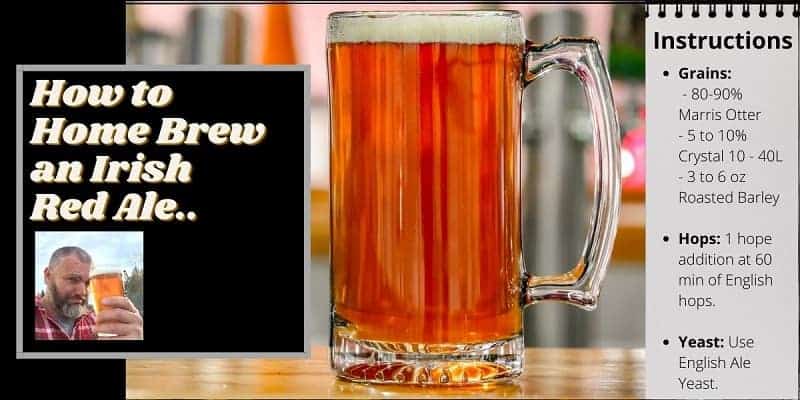In this post I am going to walk you step by step through how to home brew an Irish Red Ale. An Irish red ale is a deliciously refreshing well-balanced beer that has gained in popularity in recent years and is now enjoyed by beer lovers around the world.
To help you make this beer for yourself I am going to give you all of the details of what it should look, taste and smell like; what is involved in making this popular ale, as well as providing you with the ingredients you should use and a recipe to home brew one for yourself. 
What is an Irish Red Ale?
If I had to sum it up quickly I would tell you that it is a well-balanced beer that is known for its reddish or ruby-like color. It is an easy drinking beer that is neither overly bitter nor malty.
It does not have much of any hop smell or taste, it does have a small malt taste and smell to it however nowhere near as much as you might think it would by looking at it. And contrary to popular belief it is not an overly sweet tasting beer. It’s mouthfeel is light to medium and it has a clean finish with no real aftertaste.
History Lesson Time
As far as history lessons go this is going to be a short one, which is a good thing as you came here to learn how to home brew an Irish red ale not get a history lesson. However, understanding how and why a style of beer originated will help you brew it better.
It’s a short history lesson as there is not much documented about how this ale came into existence. Many believe that the Irish Red ale was originally simply a variation of English Bitters or Pale ales.
The most well-known and first to be documented (that I can tell) is Smithwick’s which was first brewed in the early 1700’s and eventually purchased by Guinness in the mid 1900’s. (LINK)
What is very interesting is that Irish Red ales are much more popular on this side of the pond in North America than they are back in Ireland. Although they are enjoyed there, they simply can not compete with the love the Irish have for their stouts. Guinness is simply the beer over there.
Beer Experiment: Speaking of stouts, here is something you can try if you are an adventurous beer drinker. Mix half a bottle of Irish Red Ale with half a bottle of a Dry Irish Stout. It’s a delicious concoction called a Blacksmith. Give it a try and let me know what you think of it in the comment section. See it in action here.
How it Should Look (Appearance)
If it is a true Irish Red ale it will have a medium red almost copper color to it.
Many American breweries are taking amber ales and calling them red ales so you might come across one that is called a red ale but has more of an amber color; which makes things confusing, but an amber ale is most definitely not an Irish Red ale no matter what the brewery is calling it.
The beer is typically clear and it should have a smaller sized head that would be between white and tan in color. You will typically see medium to faster rising carbonation bubbles coming up from the bottom.
What it’s Mouthfeel Should Be Like
By looking at it you might be fooled into thinking that this beer would have a heavy mouthfeel, it does not. It has more of a medium light to medium mouthfeel.
The carbonation will feel moderate and the overall beer will have a smoothness to it. Smithwicks has somewhat of a creamy mouthfeel to it, which should come as no surprise considering Guinness is known for their creamy feel.
What it Should Smell Like (Aroma)
If you are into hoppy smelling beers this is not it. There is very little to any hop aroma and if there is any it is not the citrusy American hop smell as it uses British hops.
It will have a malt smell to it but it is not overpowering, call it moderate-light. You will probably catch some light caramel or toffee notes. But none of the odors are overpowering with this beer.
How Does it Taste (Flavor)
Some might look at a pint of this beer and because of its color believe that it is going to be a very malty or sweet tasting beer; it is not. It is going to have a balanced taste that will lean towards a light to medium maltiness that will taste slightly like caramel or toffee.
It will have a dry finish that is as a result of the roasted grains which you may possibly catch a light taste of. You will most likely not catch any hop flavor and if you do it will again not be citrusy as it will be provided by the English hops and be much more tame.
Ingredients
Alright now you know how an Irish Red ale should look, taste, smell and feel. I am now going to show you the ingredients you need to use to make sure you home brew one the right way…
Grains to Use
The majority of your grain bill is going to be a pale British malt, I recommend Marris Otter as it gives it more of the bready or biscuity taste you are looking for versus what an American 2-row would.
You could use American 2-row if you had some kicking around; however you would then need to add a small amount (less than 1 lb) of a specialty grain like Munich to get the flavor you are looking for.
Next most typical recipes would have you add some crystal malt somewhere between 10 – 40 Lovibond. This is going to provide your ale with the caramel or toffee taste. Keep this specialty grain to under 10% of the total grain bill.
And lastly for most typical red ale recipes you would add a small amount of roasted barley in order to give it the reddish copper color. You do not need to add much roasted barley, a little dab’ll do ya. If you add too much it can quickly over power your beer. 3 – 6 ounces is all it will take.
Now you will notice that throughout this section I said “typically” a few times. The reason for this is that the Irish Red Ale recipe I am going to give you in this post is one that I have been working on and improving for many years. It was actually one of the best-selling beers at my brew pub.
I have tweaked it many times and you will see that I actually use CaraMunich II and Carapils in small quantities; and the crystal malt I use is actually 120 L, but only a very small amount. This is home brewing and part of the fun is tweaking your recipes to create your beers just the way you like them to be.
Hops to Use
You will most definitely want to use English hops. Do not even think about using American hops as it will completely change the style of beer and it will not be an Irish Red Ale. East Kent Goldings, Perle and Fuggles are great choices.
Do not use a lot of hops, the only hops used are at the start of the boil for bittering. The recipe I share with you uses 1.5oz at the 60-min mark of East Kent Golding.
Yeast to Use
As you know when it comes to yeast I keep it easy and use a dry yeast. This one would call for either Safale S-04 or Nottingham Ale Yeast.
But feel free to mix it up and try different yeasts. There are a lot of good liquid English yeasts you could try also.
Some people even use a lager yeast. It’s quite amazing how by only changing the yeast in a recipe you can completely alter the taste and appearance of the beer, so have fun with it.
Irish Red Ale Recipe
Alright it is time to get down to the nitty gritty and brew yourself up one of these delicious home brews.
As I said, the recipe I am going to share with you is one of my all time favorites. In fact it is 1 of my top 5 all time favorite recipes. If you want to get the other 4 you can sign up to receive them for free on the side of the blog.
I have been brewing this beer for a long time and it was a huge hit at my brew pub. If you like a red ale I am positive you are going to enjoy this one.
I call it “Sister Sarah”.
There are two reasons I named it Sister Sarah:
- I actually do have a sister named Sarah and like me she is part Irish and actually has strawberry blond hair so I thought it was fitting.
- Plus the “Sister” part of the name has somewhat of an Irish Catholic Nun feel to it so there you have it.
If you want to make this beer you can order your ingredients here! (I also recommend a really good Red Ale all grain recipe on that page)
Sister Sarah Irish Red Ale by the Numbers:
SRM: 15.19
Target OG: 1.048
Target FG: 1.010
ABV: 4.94%
IBU: 32.81
Pre Boil Volume: 7 gallons
Fermenter Volume: 5.2 gallons
Brewhouse efficiency of 70%
Grains
- 8lbs Maris Otter
- 4oz CaraMunich II or Crystal 40L
- 4oz Caramel/Crystal 120L
- 4oz Roasted Barley
- 7oz Carapils (Dextrine)
Hops
- 1.5oz East Kent Goldings (60 min)
Yeast
Any English ale yeast.
I prefer Safle U-04 or Nottingham Ale yeast
Want to brew one for yourself? You can go here to order your ingredients
Additional Resources
So it should be clear this is an all grain recipe. If you are new to all grain brewing you can learn how to do it on this post:
I have also put together a guide that covers all of the different processes such as cleaning and sanitizing your equipment, how to clear your beer, how to cold crash your wort, how to ferment and condition it, etc.
You can check that guide out here: Home Brewing Guides
Brewing Equipment
As for the actual brewing equipment you will need to brew this Irish Red ale I personally brew on the all-in-one electrical brewing systems.
I find they make incredible beer, they are much less expensive than most other systems and the clean up after a brew day takes a fraction of the time (that’s a big deal)!
You can learn about these types of systems here:
All you need to know about All-In-One Brewing Systems (electric BIAB)
You can also see which systems I recommend here:
The top 3 all-in-one brewing systems
There you have it my friend, a step by step guide on how to home brew an Irish Red ale for yourself. If you do brew it do me a favor and let me know in the comment section below. And if you have any questions on how to make this delicious beer let me know!
Now go get your brew awwnn..
Oh yeaaah,
Big Robb is out!

